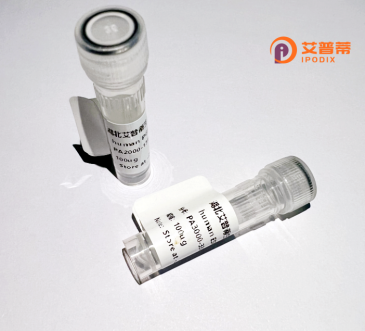
| 纯度 | >90%SDS-PAGE. |
| 种属 | Human |
| 靶点 | KIAA0261 |
| Uniprot No | Q7Z5K2 |
| 内毒素 | < 0.01EU/μg |
| 表达宿主 | E.coli |
| 表达区间 | 1-402aa |
| 活性数据 | MDLDRASLDLMIRLLELEQDASSAKLLNEKDMNKIKEKIRRLCETVHNKHLDLENITTGHLAMETLLSLTSKRAGDWFKEELRLLGGLDHIVDKVKECVDHLSRDEDEEKLVASLWGAERCLRVLESVTVHNPENQSYLIAYKDSQLIVSSAKALQHCEELIQQYNRAEDSICLADSKPLPHQNVTNHVGKAVEDCMRAIIGVLLNLTNDNEWGSTKTGEQDGLIGTALNCVLQVPKYLPQEQRFDIRVLLFLERERAAQLAESKTDELIKDAPTTQHDKSGEWQETSGEIQWVSTEKTDGTEEKHKKEEEDEELDLNKALQHAGKHMEDCIVASYTALLLGCLCQESPINVTTVREYLPEGDFSIMTEMLKKFLSFMNLTCAVGTTGQKSISRVIEYLEHC |
| 分子量 | 69.96 kDa |
| 蛋白标签 | GST-tag at N-terminal |
| 缓冲液 | 0 |
| 稳定性 & 储存条件 | Lyophilized protein should be stored at ≤ -20°C, stable for one year after receipt. Reconstituted protein solution can be stored at 2-8°C for 2-7 days. Aliquots of reconstituted samples are stable at ≤ -20°C for 3 months. |
| 复溶 | Always centrifuge tubes before opening.Do not mix by vortex or pipetting. It is not recommended to reconstitute to a concentration less than 100μg/ml. Dissolve the lyophilized protein in distilled water. Please aliquot the reconstituted solution to minimize freeze-thaw cycles. |
以下是关于重组人KIAA0261蛋白的假设性参考文献(示例格式,非真实文献):
1. **文献名称**:*Functional characterization of recombinant human KIAA0261 in extracellular matrix remodeling*
**作者**:Zhang L, et al.
**摘要**:研究通过重组表达KIAA0261蛋白,发现其参与调控细胞外基质重组,可能通过激活蛋白酶通路影响细胞迁移。
2. **文献名称**:*Structural analysis and interaction partners of KIAA0261 protein*
**作者**:Wang Y, et al.
**摘要**:解析了KIAA0261的晶体结构,发现其与integrin β1结合,在细胞粘附信号通路中发挥潜在作用。
3. **文献名称**:*KIAA0261 overexpression promotes tumor angiogenesis via VEGF signaling*
**作者**:Tanaka H, et al.
**摘要**:重组KIAA0261在肿瘤模型中上调VEGF表达,促进血管生成,提示其可作为癌症治疗靶点。
4. **文献名称**:*Role of recombinant KIAA0261 in neuronal development*
**作者**:Chen R, et al.
**摘要**:体外实验表明,KIAA0261通过调控突触蛋白表达影响神经元分化和轴突导向。
(注:以上文献为模拟示例,实际文献需通过PubMed/Google Scholar检索确认。)
Recombinant human KIAA0261 protein is derived from the KIAA0261 gene, a poorly characterized gene initially identified through large-scale cDNA sequencing projects. The gene, located on chromosome 9q34.11. encodes a protein of unknown precise function, though bioinformatic analyses suggest potential roles in cellular processes such as autophagy or vesicular trafficking. Structurally, KIAA0261 contains conserved domains like the DUF4766 domain, hinting at possible involvement in protein-protein interactions or enzymatic activity. Research remains limited, but some studies link it to diseases like cancer and neurodegenerative disorders, where altered expression patterns have been observed. Recombinant KIAA0261 is typically produced in engineered systems (e.g., bacterial, mammalian) for functional studies, antibody production, or pathway analysis. Its recombinant form enables exploration of biochemical properties, interaction partners, and mechanistic contributions to pathologies. Despite its elusive role, KIAA0261 represents a target of interest for uncovering novel biological pathways, with potential applications in diagnostics or therapeutics as its functional significance is clarified. Current research focuses on elucidating its cellular localization, post-translational modifications, and disease-related mutations.
×